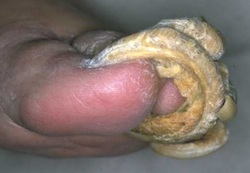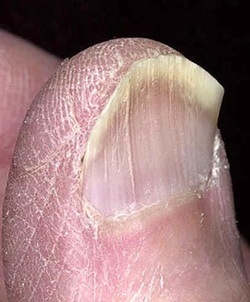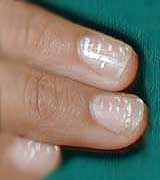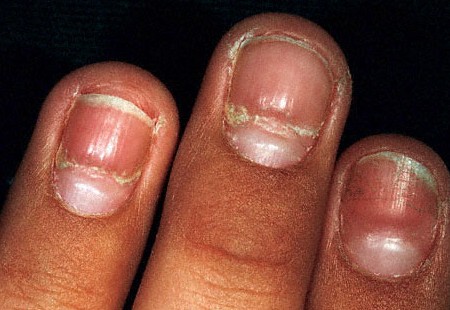Symptom finder - The causes of nail abnormalities

onychogryphosis
Symptom finder - The causes of nail abnormalities
Nail abnormalities are common. Abnormalities of the nail are associated with underlying clinical disorders. The common form of nail abnormalities are koilonychia, leuconychia , Beau’s line and onychomycosis.
There are two forms of clinical disorders associated with abnormalities of the nail. These are congenital disorder and acquired disorders. Congenital disorder is epidermolysis bullosa while acquired disorders are divided into dermatological causes ( eczema, psoriasis), trauma ( trauma to the nail bed , nail bitting) , systemic illness - Plummer Vinson syndrome - koilonychia, diabetes mellitus- leuconychia , systemic illness- Beau’s line ), psoriatic arthritis, chronic liver disease- leuconychia and iron deficiency anemia ( koilonychia). Other causes are yellow nail syndrome, autoimmune disease such as Raynaud’s phenomenon and onychogryphosis.
Dermatological causes of nail abnormalities such as eczema are characterized by itchiness which affect the flexor ( and extensor aspect in infants) diffusely. Psoriasis may present as scaly plaque on the scalp, external meatus, natal cleft, glan penis, elbows, umbilicus and knee.
Always remember to ask if the patient likes to bite her/his own nail ( nail bitter). Any traumatic condition may present with severe damage to the nail.
Nail abnormalities due to chronic paronychia are characterized by tenderness, swelling and pain in the areas of the nail fold. Fungal infection is characterized by nail discoloration.
Systemic illness that lead to nail abnormalities are chronic liver disease, psoriatic arthritis, diabetes mellitus, Plummer Vinson syndrome and iron deficiency anemia . Generally, Beaus’ line ( transverse ridges and trophic nail changes) are due to severe illness that last for almost 3 months. Patient may also has past history of hepatitis or alcohol abuse which contributes to chronic liver disease. Psoriatic arthritis are presented with stiffness, swelling and joint pain. Diabetes mellitus is associated with lethargy, polydipsia and polyuria. Iron deficiency anemia may present with minimal exertion related to shortness of breath or chest pain and lethargy. Plummer Vinson syndrome consists of dysphagia, smooth tongue and iron deficiency anemia.
Upon exposure to the cold environment, the fingers will turn into white, blue than red in case of Raynaud’s phenomenon. Nail abnormalities are also associated with sclerodactyl in systemic sclerosis and hair loss in case of alopecia areata. Yellow nail syndrome is associated with chronic sinusitis, bronchiectasis, pleural effusion and lymphedema. There will be yellow discoloration and slow growing of the nail . Great toenail is significantly affected by onychogryphosis. Onychogryphosis is presented with nail that is curls over as it is thicken while it is growing. Congenital nail abnormalities due to epidermolysis bullosa is characterized by severe disease of the skin from birth.
Always remember to ask the female patient to remove any nail varnish before inspecting the nail.
Traumatic nail abnormalities are characterized by malformation of the nail or nail may be bitten back to the nail bed.
Psoriatic arthritis that present with dystrophy of the nail and chronic fungal infection need to be differentiated. Psoriatic arthritis may present with sliver scaly plaque on the extensor surface of the body ( localized or diffuse) while chronic fungal infection is presented with thick, discolored and malformation of the nail. Nail clipping is considered to confirm the diagnosis before starting any anti fungal or immunosupressive therapy. Eczema turns out to be itchy in nature and characterized as diffuse or localized lesion. Chronic paronychia is typically present as tender, swollen and red nail fold.
Nail abnormalities are common. Abnormalities of the nail are associated with underlying clinical disorders. The common form of nail abnormalities are koilonychia, leuconychia , Beau’s line and onychomycosis.
There are two forms of clinical disorders associated with abnormalities of the nail. These are congenital disorder and acquired disorders. Congenital disorder is epidermolysis bullosa while acquired disorders are divided into dermatological causes ( eczema, psoriasis), trauma ( trauma to the nail bed , nail bitting) , systemic illness - Plummer Vinson syndrome - koilonychia, diabetes mellitus- leuconychia , systemic illness- Beau’s line ), psoriatic arthritis, chronic liver disease- leuconychia and iron deficiency anemia ( koilonychia). Other causes are yellow nail syndrome, autoimmune disease such as Raynaud’s phenomenon and onychogryphosis.
Dermatological causes of nail abnormalities such as eczema are characterized by itchiness which affect the flexor ( and extensor aspect in infants) diffusely. Psoriasis may present as scaly plaque on the scalp, external meatus, natal cleft, glan penis, elbows, umbilicus and knee.
Always remember to ask if the patient likes to bite her/his own nail ( nail bitter). Any traumatic condition may present with severe damage to the nail.
Nail abnormalities due to chronic paronychia are characterized by tenderness, swelling and pain in the areas of the nail fold. Fungal infection is characterized by nail discoloration.
Systemic illness that lead to nail abnormalities are chronic liver disease, psoriatic arthritis, diabetes mellitus, Plummer Vinson syndrome and iron deficiency anemia . Generally, Beaus’ line ( transverse ridges and trophic nail changes) are due to severe illness that last for almost 3 months. Patient may also has past history of hepatitis or alcohol abuse which contributes to chronic liver disease. Psoriatic arthritis are presented with stiffness, swelling and joint pain. Diabetes mellitus is associated with lethargy, polydipsia and polyuria. Iron deficiency anemia may present with minimal exertion related to shortness of breath or chest pain and lethargy. Plummer Vinson syndrome consists of dysphagia, smooth tongue and iron deficiency anemia.
Upon exposure to the cold environment, the fingers will turn into white, blue than red in case of Raynaud’s phenomenon. Nail abnormalities are also associated with sclerodactyl in systemic sclerosis and hair loss in case of alopecia areata. Yellow nail syndrome is associated with chronic sinusitis, bronchiectasis, pleural effusion and lymphedema. There will be yellow discoloration and slow growing of the nail . Great toenail is significantly affected by onychogryphosis. Onychogryphosis is presented with nail that is curls over as it is thicken while it is growing. Congenital nail abnormalities due to epidermolysis bullosa is characterized by severe disease of the skin from birth.
Always remember to ask the female patient to remove any nail varnish before inspecting the nail.
Traumatic nail abnormalities are characterized by malformation of the nail or nail may be bitten back to the nail bed.
Psoriatic arthritis that present with dystrophy of the nail and chronic fungal infection need to be differentiated. Psoriatic arthritis may present with sliver scaly plaque on the extensor surface of the body ( localized or diffuse) while chronic fungal infection is presented with thick, discolored and malformation of the nail. Nail clipping is considered to confirm the diagnosis before starting any anti fungal or immunosupressive therapy. Eczema turns out to be itchy in nature and characterized as diffuse or localized lesion. Chronic paronychia is typically present as tender, swollen and red nail fold.

koilonychia ( spoon shaped nail)
Spoon shaped nail ( koilonychia), angular cheilitis and pallor are characteristic of iron deficiency anemia. Swollen and deformed joints are commonly present due to psoriatic arthritis.Psoriatic plaque also need to be observed. In severe cases of psoriatic arthritis, psoriatic nail dystrophy may present. Observe for any features of chronic liver disease or diabetes as both of them are related to leuconychia.
Yellow nail syndrome present as slow growing and yellow discoloration of the nail. Lower limb will be affected by lymphedema.Patient may present with ascites, pleural effusions and bronchiectasis. Onychogryphosis is presented as deformation of the great toe nail which is gross in character and presented as curls over and thickens as the nail grow with atrophic changes of the distal finger due to Raynaud’s phenomenon.
The common laboratory investigations performed are full blood count, liver function test, urinalysis, blood glucose, blood film, ANA, nail clippings , chest x ray, hand x ray and skin biopsy.
Full blood count may reveal low Hb level, low MCV level and low MCHC level. Liver function test is useful to rule out chronic liver disease such as cirrhosis. Urinalysis is useful for diabetes. Low level of serum ferittin is due to iron deficiency anemia.Iron deficiency anemia may also present with increase total iron binding capacity and low level of serum iron. Blood glucose is used to detect diabetes. Blood film may reveal the present of microcytic red blood cell in iron deficiency anemia. Systemic sclerosis is detected with ANA. Fungal infections are associated with nail clippings. Chest x ray is useful to detect any abnormalities of the chest that is due to pleural effusion or bronchiectasis as a result of yellow nail syndrome. Hands x rays are useful for psoriatic arthritis and skin biopsy for eczema and psoriasis.
Yellow nail syndrome present as slow growing and yellow discoloration of the nail. Lower limb will be affected by lymphedema.Patient may present with ascites, pleural effusions and bronchiectasis. Onychogryphosis is presented as deformation of the great toe nail which is gross in character and presented as curls over and thickens as the nail grow with atrophic changes of the distal finger due to Raynaud’s phenomenon.
The common laboratory investigations performed are full blood count, liver function test, urinalysis, blood glucose, blood film, ANA, nail clippings , chest x ray, hand x ray and skin biopsy.
Full blood count may reveal low Hb level, low MCV level and low MCHC level. Liver function test is useful to rule out chronic liver disease such as cirrhosis. Urinalysis is useful for diabetes. Low level of serum ferittin is due to iron deficiency anemia.Iron deficiency anemia may also present with increase total iron binding capacity and low level of serum iron. Blood glucose is used to detect diabetes. Blood film may reveal the present of microcytic red blood cell in iron deficiency anemia. Systemic sclerosis is detected with ANA. Fungal infections are associated with nail clippings. Chest x ray is useful to detect any abnormalities of the chest that is due to pleural effusion or bronchiectasis as a result of yellow nail syndrome. Hands x rays are useful for psoriatic arthritis and skin biopsy for eczema and psoriasis.


